- Home
- »
- Pharmaceuticals
- »
-
Infant Nutrition Market Size, Share And Growth Report, 2030GVR Report cover
![Infant Nutrition Market Size, Share & Trends Report]()
Infant Nutrition Market Size, Share & Trends Analysis Report By Product Type (Infant Milk Formula, Baby Food), By Form (Solid, Liquid), By Sales Channel, By Region, And Segment Forecasts, 2024 - 2030
- Report ID: GVR-4-68040-163-0
- Number of Report Pages: 120
- Format: PDF, Horizon Databook
- Historical Range: 2018 - 2022
- Forecast Period: 2024 - 2030
- Industry: Healthcare
Infant Nutrition Market Size & Trends
The global infant nutrition market size was estimated at USD 365.6 million in 2023 and is anticipated to grow at a compound annual growth rate (CAGR) of 7.7% from 2024 to 2030. The market growth is driven by various factors, such as increasing awareness and acceptance of infant nutrition products, urbanization, and changing lifestyles. The demand for specialized infant nutrition products is growing as parents prioritize their children's health and seek products tailored to specific nutritional needs during crucial stages of infancy. For instance, in May 2023, Arla Foods Ingredients introduced a new alpha-lactalbumin-rich infant formula ingredient to address the increasing demand for low-protein formulations.
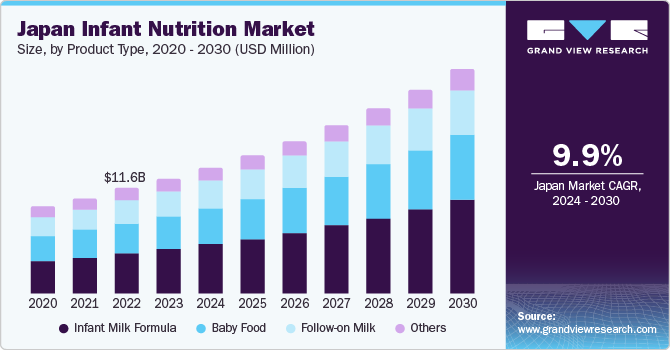
The increasing investments to raise birth rates in several countries contribute to the growing demand for infant nutrition throughout the forecast period. For instance, in June 2023, Japan announced to invest around USD 24 billion (3.5 trillion yen) to raise its fertility rate. The growing number of working mothers, increased spending on infant health, and growing demand for organic baby food are some of the factors driving the market's expansion. The number of young working mothers has increased dramatically in the last several years.
Due to the heavy reliance on processed infant nutrition products, working women have played a significant role in driving the expansion of the infant nutrition industry. In June 2023, according to a survey published by THE JAPAN TIMES LTD. in 2022, there were a record 30.35 million working women in Japan, an increase of 1.22 million from the previous five years. Similarly, as per AXIOS’ September 2023 update, women with children under five made up 70.4% of the working population in June 2023, down from 68.9% at the pandemic's peak.
As more women join the workforce and pursue professional careers, the need for convenient and time-saving solutions for infant feeding has risen substantially. Working mothers often face challenges in managing the demands of their jobs along with the responsibilities of caring for their infants. This has led to an increased reliance on infant nutrition products that offer convenience, ease of preparation, and nutritional assurance.
Moreover, the originating trend of dual-income households and busy lifestyles has also fueled the demand for convenient and ready-to-feed infant nutrition solutions, contributing to market expansion. In addition, the influence of social media has facilitated the dissemination of information about the latest and most effective infant nutrition products, driving consumer choices. Overall, a combination of health consciousness, technological advancements, and changing lifestyles are propelling the growth of the market.
Market Concentration & Characteristics
The global infant nutrition industry is characterized by a high degree of innovation. With continuous advancements and improvements in product formulations, manufacturing processes, and packaging. The launch of allergen-free and hypoallergenic products and the trend for organic and natural ingredients allow manufacturers to offer new and effective products.
Key market players, including Nestlé, Walgreen Co., Nutricia, Abbott, and The Hain Celestial Group, engage in merger and acquisition activities to broaden their product portfolio and geographical reach. For example, in July 2023, Bobbie, a provider of clean-label infant formula, acquired an Ohio-based pediatric nutrition company, Nature’s One. This acquisition grants Bobbie control over its entire production process, from raw material sourcing to canning.
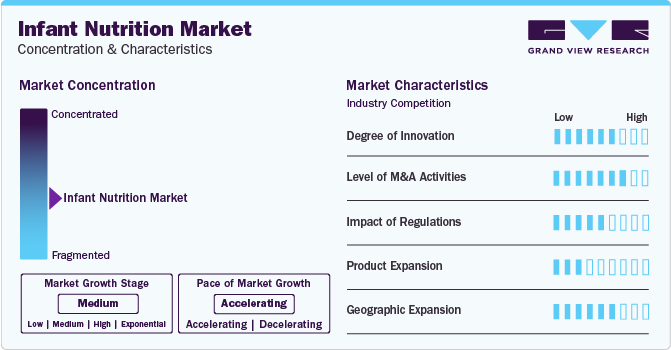
Regulatory bodies such as the FDA and European Commission set standards for the nutritional and composition content of infant nutrition products. These standards are designed to ensure that products meet the specific dietary needs of infants and are safe for consumption. Regulations governing the levels of vital nutrients like vitamins, minerals, proteins, and lipids must be followed by formulas. Compliance with these standards is required for market access and customer confidence.
There is no direct substitute for infant nutrition products. Plant-based newborn formulae and baby meals are becoming popular. These substitutes are frequently produced with soy, almond, or rice milk.
Sales Channel Insights
The hypermarket/supermarket segment holds the market dominance with the largest share in 2023. Hypermarkets and supermarkets, such as SM Market, Walmart, Amazon, Morrisons, and others, provide a convenient one-stop shopping experience for parents seeking infant nutrition products alongside groceries and household items. The appeal of this convenience factor drives consumer preference for these retail channels. Companies are increasingly launching their products in hypermarkets/supermarkets to enhance sales. For instance, in July 2023, Else Nutrition expanded its distribution in the Midwest market through a partnership with Schnucks, a major regional supermarket chain. The Else Toddler Organic 22oz product is now available at approximately 110 Schnucks locations across Missouri, Wisconsin, Illinois, and Indiana.
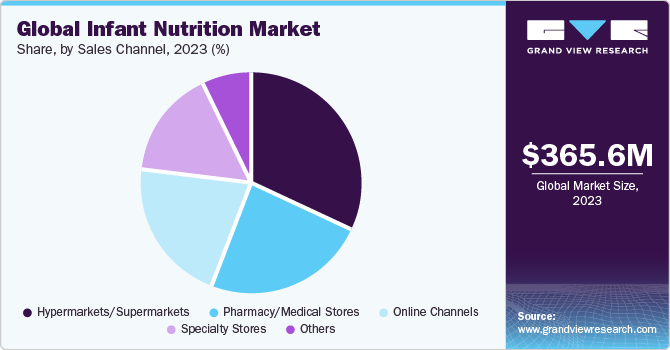
Online channels segment is anticipated to grow at the fastest CAGR during the forecast period. Online platforms offer a broad range of infant nutrition products, including various formulas, baby food, and supplements. This extensive product selection allows consumers to explore different options and choose products that meet their preferences and requirements. The increasing internet penetration and global shift towards online shopping would likely drive the segment growth over the forecast period.
Product Type Insights
Infant milk formula segment held the largest revenue share of 38.9% in 2023. The market dominance was fueled by heightened parental awareness of optimal infant nutrition and the convenience of formula feeding. Continuous innovation in baby formula with formulations closely resembling breast milk nutrition appeals to consumers seeking specialized and high-quality options. Shifting lifestyles, including more working mothers and the prevalence of nuclear families, drive the adoption of infant milk formula as a convenient feeding choice. Manufacturers respond by offering diverse newborn formula products to meet varying dietary needs. For instance, in September 2022, Nestlé launched Nutrilearn Connect, featuring myelin, a unique ingredient, in Hong Kong.
Baby food segment is anticipated to witness significant market growth over the forecast period. Companies are strategically offering a diverse range of convenient and nutritious options for parents, capitalizing on the rising popularity of ready-to-eat and easy-to-prepare baby food to meet the demand for time-saving solutions. These factors contribute to the sustained growth of the segment throughout the forecast period.
Regional Insights
North America dominated the market with a revenue share of 24.8% in 2023, driven by factors such as the increasing number of working women, government support for quality healthcare, high purchasing power parity, and the presence of key market players. In the U.S., the proportion of working women is increasing. For instance, according to a Catalyst Organization analysis published in August 2022, there were 75,699,000 women aged 16 and up in the labor force in 2021, representing 56.1% of all women in the U.S. population and nearly half (47.0%) of the entire labor force. This trend highlights the growing reliance of working mothers on infant/baby nutrition, enabling them to feed their newborns conveniently, even in their absence.
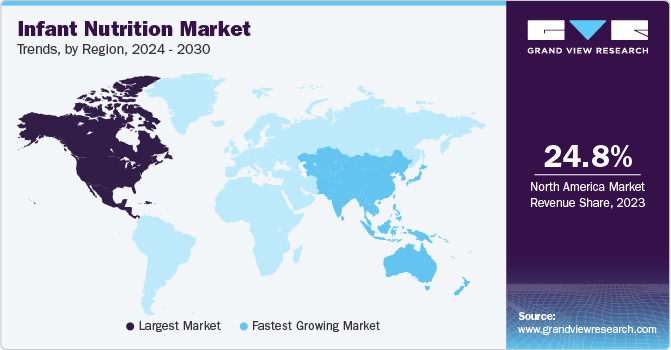
Simultaneously, the region is witnessing strategies such as new product launches by startups and established baby-feeding companies. For instance, Sugarlogix, a startup, leverages advanced gene-editing technologies to replicate the most common breast milk sugars in a lab known for enhancing the baby's immune system. In addition, Bobbie Labs, its research, and development unit focused on enhancing newborn nutrition, was inaugurated in October 2022. Bobbie Labs is a crucial element of Bobbie's USD 100 million commitment to improve infant formula accessibility, quality, and choices for all US families.
The Asia Pacific region is anticipated to witness the fastest CAGR during the forecast period due to a rising number of childbirths and an increasing population of working women. The combination of high birth rates in some APAC countries and growing urbanization contributes to a large and expanding consumer base for infant nutrition products.
Form Insights
Solid form segment held the largest revenue share in 2023. Powdered infant formulas offer greater convenience and portability than liquid alternatives, making them a preferred choice for on-the-go parents or those who prefer flexibility in preparation. In addition, powdered formulas are generally more cost-effective than ready-to-feed or liquid concentrates, attracting price-sensitive consumers.
The liquid form segment is anticipated to witness a significant CAGR, driven by pre-packaged and sealed options, addressing contamination concerns, and appealing to parents prioritizing hygiene and safety.
Key Companies & Market Share Insights
-
Nestlé, Nutricia, Abbott, Perrigo Company plc, and China Mengniu Dairy Company Limited are some of the notable players in the infant nutrition industry.
-
Nestlé, a global brand with over 2,000 products in 188 countries, operates 344 manufacturing facilities in 77 countries
-
Nutricia has a global presence in over 100 countries, serving adult and baby/child categories
-
Abbott, a global healthcare product manufacturer, operates in 160+ countries, offering diverse products
-
Walgreen Co., Holle baby food AG, The Kraft Heinz Company, and DANA DAIRY GROUP are emerging players in the infant nutrition industry.
-
Holle baby food AG operates globally in 50+ countries, offering a portfolio of over 90 infant and baby products
-
The Kraft Heinz Company, with 78 manufacturing sites, collaborates with nearly 5,550 suppliers and 210 external manufacturers
Key Infant Nutrition Companies:
- Nestlé
- Walgreen Co.
- Nutricia
- Abbott
- The Hain Celestial Group
- Holle baby food AG
- China Mengniu Dairy Company Limited
- Perrigo Company plc,
- The Kraft Heinz Company
- DANA DAIRY GROUP
Recent Developments
-
In October 2023, Nestlé introduced a new commercial blend of infant nutrition Sinergity, containing a probiotic strain with variable stages of 6 human milk oligosaccharides (HMOs) to help the development of infants through their life stages
-
In September 2023, Danone announced launch of a novel infant formula in China containing milk droplets that closely mimic the structure found in mothers’ milk
-
In August 2023, ByHeart announced its first retail launch: its clinically proven, easily digestible, and certified-clean ingredients newborn formula that will be available at Target stores across the U.S. In addition, the company declared that later this year, it will reintroduce its product directly to consumers at ByHeart.com
-
In July 2023, Bobbie Baby acquired Nature’s One, an Ohio-based pediatric nutrition company. The aim behind the acquisition is to oversee the whole production process of Nature's One, from procuring raw materials to canning
-
In April 2023, Danone announced expansion of its nutrition portfolio in Poland by acquiring ProMedica
Infant Nutrition Market Report Scope
Report Attribute
Details
Market size value in 2024
USD 392.1 million
Revenue forecast in 2030
USD 611.1 million
Growth rate
CAGR of 7.7% from 2024 to 2030
Base year for estimation
2023
Historical data
2018 - 2022
Forecast period
2024 - 2030
Quantitative units
Revenue in USD million/billion and CAGR from 2024 to 2030
Report coverage
Revenue forecast, company ranking, competitive landscape, growth factors, and trends
Segments covered
Product type, form, sales channel, region
Regional scope
North America; Europe; Asia Pacific; Latin America; MEA
Country scope
U.S.; Canada; UK; Germany; France; Italy; Spain; Denmark; Sweden; Norway; Japan; China; India; Australia; Thailand; South Korea; Brazil; Mexico; Argentina; South Africa; Saudi Arabia; UAE; Kuwait.
Key companies profiled
Nestlé; Walgreen Co.; Nutricia; Abbott; The Hain Celestial Group; Holle baby food AG; China Mengniu Dairy Company Limited; Perrigo Company plc; The Kraft Heinz Company; DANA DAIRY GROUP
Customization scope
Free report customization (equivalent up to 8 analysts working days) with purchase. Addition or alteration to country, regional & segment scope.
Pricing and purchase options
Avail customized purchase options to meet your exact research needs. Explore purchase options
Global Infant Nutrition Market Report Segmentation
This report forecasts revenue growth at global, regional & country levels and provides an analysis of the industry trends in each of the sub-segments from 2018 to 2030. For this study, Grand View Research has segmented the global infant nutrition market report based on product type, form, sales channel, and region:
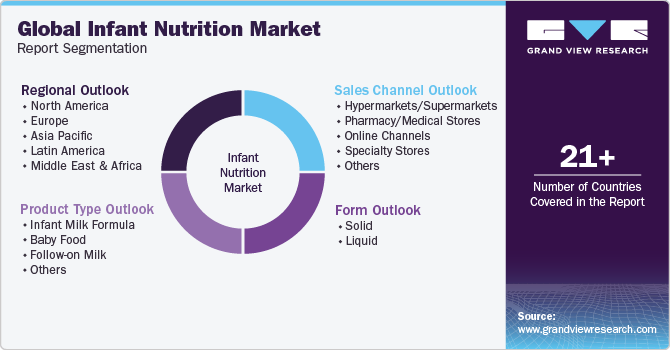
-
Product Type Outlook (Revenue, USD Million, 2018 - 2030)
-
Infant Milk Formula
-
Baby Food
-
Follow-on Milk
-
Others
-
-
Form Outlook (Revenue, USD Million, 2018 - 2030)
-
Solid
-
Liquid
-
-
Sales Channel Outlook (Revenue, USD Million, 2018 - 2030)
-
Hypermarkets/Supermarkets
-
Pharmacy/Medical Stores
-
Online Channels
-
Specialty Stores
-
Others
-
-
Regional Outlook (Revenue, USD Million, 2018 - 2030)
-
North America
-
U.S.
-
Canada
-
-
Europe
-
UK
-
Germany
-
France
-
Italy
-
Spain
-
Denmark
-
Sweden
-
Norway
-
-
Asia Pacific
-
China
-
Japan
-
India
-
Australia
-
Thailand
-
South Korea
-
-
Latin America
-
Brazil
-
Mexico
-
Argentina
-
-
Middle East & Africa
-
South Africa
-
Saudi Arabia
-
UAE
-
Kuwait
-
-
Frequently Asked Questions About This Report
b. The global infant nutrition market size was estimated at USD 365.6 million in 2023 and is expected to reach USD 392.1 million in 2024.
b. The global infant nutrition market is expected to grow at a compound annual growth rate of 7.7% from 2024 to 2030 to reach USD 611.1 million by 2030.
b. North America dominated the infant nutrition market with a share of 24.8% in 2023, driven by factors such as the increasing number of working women, government support for quality healthcare, high purchasing power parity, and the presence of key market players.
b. Some key players operating in the infant nutrition market include Nestlé, Walgreen Co., Nutricia, Abbott, The Hain Celestial Group, Holle baby food AG, China Mengniu Dairy Company Limited, Perrigo Company plc, The Kraft Heinz Company, DANA DAIRY GROUP
b. The market is driven by various factors, such as increasing awareness and acceptance of infant nutrition products, urbanization, and changing lifestyles.
Share this report with your colleague or friend.
![gvr icn]()
NEED A CUSTOM REPORT?
We can customize every report - free of charge - including purchasing stand-alone sections or country-level reports, as well as offer affordable discounts for start-ups & universities. Contact us now
![Certified Icon]()
We are GDPR and CCPA compliant! Your transaction & personal information is safe and secure. For more details, please read our privacy policy.
We are committed towards customer satisfaction, and quality service.
"The quality of research they have done for us has been excellent."





